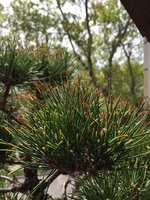I think it isn't needlecast. I think it's nutrient burn.
Needlecast creates bands, bands that occur on random locations on the needles, bands that sometimes have a spot in the center where the fungus penetrated the needle at first. If you've seen it, you'll know it.
When a plant gets a little too much salts in the system, the foliage tips tend to 'burn' in an even fashion throughout the entire plant. This can't be restored in the sense that these tips turn green again, but it can be stopped from spreading by easing up on the nutrients. This isn't a JBP specific issue, all plants seem to have the same response to salt stress.
Other root issues can have similar effects, but we don't know the history of this tree nor do we know its conditions. It's spring time, so I'm going with the most likely explanation.


